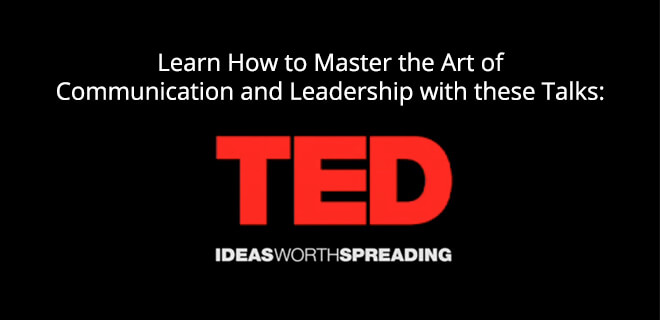
Top TED Talks about Effective Communication in the Workplace.
- How Great Leaders Inspire Action – Simon Sinek
- How to Get Your Ideas to Spread – Seth Godin
- Everyday Leadership – Drew Dudley
- What it Takes to be a Great Leader – Roselinde Torres
- The Tribes We Lead – Seth Godin
- The Puzzle of Motivation – Dan Pink
- Lead Like the Great Conductors – Itay Talgam
- Tribal Leadership – David Logan
- Learning Leadership’s Missing Manual – Fields Wicker-Miurin
- How to Start a Movement – Derek Sivers
- How Good Leadership Makes You Feel Safe – Simon Sinek
- The Secret Structure of Great Thoughts – Nancy Duarte
- How Generational Stereotypes Hold Us Back at Work – Leah Georges
- Your Body Language May Shape Who You Are – Amy Cuddy
- How to Speak so That People Want to Listen – Julian Treasure
- The Danger of Silence – Clint Smith
- Catherine Molloy: Think before you speak, hacking the secret of communication
If you are part of management in your organization, then you know how important effective communication in the workplace is. You cannot lead successfully if you do not communicate effectively. The same goes for the environment you install for your employees. Now more than ever, innovation and creativity are key, so you need your staff working together, talking together, and comfortable enough to share ideas with you this is the foundation of a successful work environment. Internal communications software will streamline these efforts, but you need to continually develop how you and your business communicates.
Poor communication can lead to misunderstandings, decreased morale, and reduced productivity. To avoid these pitfalls, focus on communicating effectively by understanding and implementing workplace effective communication strategies. Encouraging team communication and utilizing different communication channels can help ensure that everyone is on the same page. Additionally, being aware of and adapting to various communication styles within your team can significantly improve interactions and collaboration.
A great place to tap into the world’s greatest thinkers about leadership and communication in the workplace is TED Talks. To save you time, I’ve sorted through the archives to compile the ultimate list of speakers that will help you hone your communication and leadership skills. Learning how to lead and communicate can benefit your working relationships and result in fewer misunderstandings, but it is a is a conscious effort that must be learned consistently if you want to see improved productivity and more effective communication in your workplace.
Here are 16 of the best TED talks that can help you master the art of communication in a leadership role.
1. Simon Sinek: How Great Leaders Inspire Action
There’s something that differentiates the world’s greatest leaders and companies. It’s not what they offer but why they’re doing it and how they convey that purpose. Simon Sinek’s “How Great Leaders Inspire Action” garnered over 44 million views and is the third most watched video on TED.com, making it one of the most popular TED Talks about effective communication.
In it, Sinek uses Apple, Martin Luther King Jr., and the Wright brothers to pinpoint what makes successful leaders. Using his model, known as “The Golden Circle”, Sinek explains why some leaders are able to inspire while others fail to do that.
What drives behavior?
Do people buy what you believe or why you believe it?
How are you communicating your message?
By focusing on the why and working your way through the how, and ending on the what, Sinek shows what it takes to make your business exceptional.
2. Seth Godin: How to Get Your Ideas to Spread
The best thing since sliced bread. We’ve all heard the saying, and few would argue against it. You’d be surprised, then, to learn that it took 15 years on the market for people to buy sliced bread. How is this possible… how couldn’t such a simple yet revolutionary concept sell itself?
Success depends on how the idea is crafted and dispersed, Seth Godin, business executive and marketing master, explains. (In case you were wondering, sliced bread didn’t take off until Wonder rebranded the idea.) If you can properly spread your ideas, as Wonder did, you win. But first, you need to know how to stand out in a world with too many choices and not enough time for average consumers to care about other options. This comes down to a remarkable idea or a remarkable execution of how you communicate an idea. Then, you must target the right group.
Godin’s Ted Talk covers effective communication in how the message is packaged, delivered and received – how you communicate your idea to generate buyers and reach success.
3. Drew Dudley: Everyday Leadership
Everyone is a leader. In six minutes, Drew Dudley gives a comically motivating talk about how influential you already are. Leadership is frequently viewed as an unattainable, Steve Jobs-esque takeover of the world… but this is not accurate. Case in point: lollipop moments. You probably have no idea what I’m talking about, but the truth is, everyone is part of a lollipop moment and few know it.
What are lollipop moments?
The Lollipop Moment refers to a moment when someone said or did something that you feel made your life fundamentally better. In his talk, Dudley recounts a personal story where a simple, kind gesture involving a lollipop changed someone’s life. This moment, though seemingly insignificant at the time, had a profound impact on the recipient.
The importance of the Lollipop Moment lies in recognizing and celebrating these small, everyday acts of leadership. It emphasizes that true leadership is not always about grand gestures or high-level decisions, but often about everyday interactions and the positive impact they can have on others. By acknowledging these moments, we can foster a culture of appreciation and encouragement, improving team communication and building stronger working relationships. Watch Dudley’s TED Talk about effective communication to understand how impactful you can be.
4. Roselinde Torres: What It Takes to be a Great Leader
Organizations are struggling to balance the realities of today with the unknowns of tomorrow. Roselinde Torres uses her 25-plus years of experience studying leadership to explain what it takes to survive in the 21st century. For many companies with widening leadership gaps, the issue tends to be an outdated image of a leader and inadequate development programs to nurture those roles.
Torres identifies the characteristics your company should have and the internal preparation practices that optimizes success for everyone in your business.
Get answers to the following questions:
What makes a great leader in the 21st century?
How can you determine if your organization is running successfully?
How do you build a successful business with longevity?
You don’t need teams of Supermans and extensive resources to lead. But you do need the courage to look ahead.
5. Seth Godin: The Tribes We Lead
The days of pushing average ideas to the masses are gone. Today, you need a unique idea, a person to lead the vision, and a group of people who believe in it. Anyone can do it… ask Seth Godin.
Godin argues that to lead successfully, you need to find something worth changing and then assemble groups of people, or tribes, around that idea. These tribes already exist on the Internet, where silos of interests have formed their own communities. It’s not about persuading the masses to want an average object they don’t have; it’s about tapping into what’s already there and making it better. Those who believe in it will follow.
There is, of course, more to it. Watch Godin’s 17-minute TED Talk about finding the right tribes to lead effectively.
6. Dan Pink: The Puzzle of Motivation
If you offer someone a reward, they’ll perform the task exceptionally… right? Dan Pink says no. And so does science.
There’s a mismatch between what science knows and what business does. Pink, lawyer and bestselling author, explains how to motivate employees to reach peak performance in today’s market.
Spoiler alert: the carrot and stick method doesn’t work anymore.
Today’s jobs require far more right-brain, creative, conceptual thinking. Contingent motivators – bonuses or salary raises – are great for simple tasks with a clear solution. For many modern jobs, though, they narrow our focus and destroy creativity.
Not to worry! Behavioral scientists have a solution for us. Watch Pink’s TED Talk to find out the three integral building blocks to entice and motivate your company.
7. Itay Talgam – Lead Like the Great Conductors
Creating harmony without saying a word. This is a challenge that every conductor of an orchestra must tackle and whether you realize it or not, it’s a powerful lesson for your leadership role.
You might be wondering, “What the heck can an orchestra teach me about effective communication in the workplace?” More than you think. Picture an orchestra – it’s a large body of people with one shared goal, divided into sub-groups with their specific goal, trickled down to the individual level. Everyone has a job, and everyone must work harmoniously together. The conductor is guiding every piece to fruition.
There are different approaches to accomplish this, each with its own valuable insight. Watch Talgam’s Ted Talk about “doing without doing”.
8. David Logan: Tribal Leadership
There’s a good reason why tribes are a recurring theme for many TED Talks about communication. Tribes are a fundamental concept in sociology because they are everywhere… even if you are part of a tribe right now.
New York Times bestseller and USC faculty member David Logan demonstrates how tribes can expand your company. You could be the ultimate expert in your industry but if you don’t understand human psychology and sociology, you will not be an effective leader in your field. Communication, motivation, progression, and connection propels your business forward and produces the ultimate creativity and innovation.
Logan will walk you through the five stages of tribes and how your organization can move a stage up.
9. Fields Wicker-Miurin: Learning from Leadership’s Missing Manual
Is there a user’s manual for leadership?
No… and it would be a daunting task. There are too many leaders, with different goals and different challenges. There is, however, one shared trait that all successful leaders have:
The ability to see and adapt to change.
Fields Wicker-Miurin, the co-founder of Leaders Quest and director of CDC Group, shares stories about three varying local leaders – Benki, leader of the Ashaninka nation, Sanghamitra Lyengar, and Dr. Fan Jianchuan. Their visions and ability to effectively communicate their goals greatly impacted their communities for the better.
If you want to lead, guide, and create change… Wicker-Miurin’s TED Talk about leadership will give you an invaluable overview of how to make a positive, lasting impact.
10. Derek Sivers: How to Start a Movement
What does a shirtless man dancing on a field have in common with leaders improving communication in the workplace? Both are building a movement.
After all, every successful organization drives movements – whether it’s selling a product, providing a service, or advocating a mission. While the leader is no doubt invaluable to the equation, the first follower who breaks away from the sidelines is just as instrumental to spreading a message.
In three minutes, music producer and author Derek Sivers draws unexpected lessons entrepreneurs, business owners, and managers can take from an outdoor dance party.
11. Simon Sinek: Why Good Leaders Make You Feel Safe
So often authority figures and leaders are viewed as the same. A leader guides action through direction. This means power, which means authority… right?
Negative. A leader guides action through trust and cooperation. An authority figure demands action through fear. Leadership is not about instructing, but about tapping into emotion by putting people first. As with everything, you must communicate these ethics deep into your culture.
You may remember Sinek’s “How Great Leaders Inspire Action” in #1. If you value what you’re doing, who’s helping you do it, and how you communicate, you will build a foundation that will do everything in its power to not break.
12. Nancy Duarte: The Secret Structure of Great Thoughts
An idea does not take off on its own. How you communicate that idea is what drives it to success.
Whether you’re giving a presentation or leading an organization, you must articulate your message in a way that resonates with your audience otherwise you will not get movement. Nancy Durate demonstrates how to arch your message in a way that incites connection and action.
It doesn’t matter where you work or what your role is… everyone can take a piece of wisdom from this TED Talk to improve communication skills.
https://www.ted.com/talks/nancy_duarte_the_secret_structure_of_great_talks
13. Leah Georges: How Generational Stereotypes Hold Us Back At Work
The multigenerational workplace is a topic of concern for many companies. (Here’s some more insight into millennial stereotypes.) There’s no argument that a 60-year-old person has different interests than a 23-year-old, but according to Leah Georges, a lot of the current generational discourse is exactly what we call it: stereotypes.
Georges makes a case for throwing away generational stereotypes and instead focusing on their “onlyness”. When you view a person, or group of people, as individuals with their unique set of challenges and talents, you gain the capacity to understand, which breeds richer working environments. The only way to do this is by communicating. If you’re in a leadership role, encourage employees to talk to each other. (Here are some ideas about improving communication in the workplace). If you’re an employee, talk to your colleagues.
A team that works together, succeeds together.
https://www.ted.com/talks/leah_georges_how_generational_stereotypes_hold_us_back_at_work
14. Amy Cuddy: Your Body Language May Shape Who You Are
We’ve spoken a great deal about communicating ideas, how people process your messages, and how to create successful environments. But what about body language?
How we present ourselves sends a message to those we are communicating with and also influences our own beliefs about ourselves. Amy Cuddy, social psychologist and Harvard University professor shares numerous studies that support the power of body language and how it can shape the mind.
On a basic level, you’ve probably heard these concepts before. Handshakes are stressed in interview preparations – you must give a firm handshake to exude confidence and assertiveness. This scenario explains how nonverbal communication is still communication. This is an important point for improving communication in the workplace.
Cuddy teaches us all how to convey the attitudes we want others to receive, and more importantly, ourselves.
https://www.ted.com/talks/amy_cuddy_your_body_language_shapes_who_you_are
15. Julian Treasure: How to Speak so That People Want to Listen
There’s a missing piece to our conversations about communication in the workplace… and it’s your voice. Yes, you heard me. The actual sounds you make, or don’t make, in important discussions, presentations, or everyday speech has an effect on how people digest your words… if at all.
Julian Treasure, sound and communication expert, covers major aspects of how you deliver your thoughts – avoiding the “Seven Deadly Communication Sins”, how to speak with more empathy, and vocal exercises, so you can capture, retain, and create a good repertoire with the people you want to communicate with.
Treasure has numerous TED Talks on effective communication (five to be exact) – check out another personal favorite, “5 Ways to Listen Better”.
https://www.ted.com/talks/julian_treasure_how_to_speak_so_that_people_want_to_listen
16. Clint Smith: The Danger of Silence
One of the most harmful roadblocks in a workplace is a lack of communication. You want a free flow of thoughts and conversations so your organization, and everyone in it, can expand and evolve. Clint Smith’s powerful TED Talk on communication explores what the world looks like when people do not speak up.
Smith, poet, author, and scholar, demonstrates ways to communicate better in our everyday lives. It was important for me to share this TED Talk with you because it has an invaluable lesson for you, as a leader and human: encouraging discussion stimulates action, while silence spurs destruction and harm. “Silence is the residue of fear,” says Smith.
Take a hard look at your workplace culture and the way your organization functions. Are your people heard? Do employees approach you with ideas or speak up when they think there’s room for improvement? Is there chatter within your business and are there open lines of communication between management and team members?
If you answered no to any of these questions, you need to reconstruct your internal communication strategy to build an environment where members feel secure and valued. A company that nurtures effective communication will soar through challenging times and successes.
https://www.ted.com/talks/clint_smith_the_danger_of_silence
17. Catherine Molloy: Think before you speak, hacking the secret of communication
You might think that you have communicated, however have you really? this talk explores the impact communication can have both negative and positive and how we can hack conscious communication.
It’s all too common in the workplace that we feel we have communicated something only to be misunderstood. We all make up stories based on people’s reactions, body language or non-verbal communication based on the 1000’s of thoughts going through our brains, but rarely do we ask people what went wrong.
Consciously communicating at work, and letting people know exactly what you mean, comes from knowing how your body language is understood by other people.
Improve Workplace Communication and Dynamics with TED Talks
Effective communication in the workplace is not just a nice-to-have skill, but a crucial component for building strong teams, promoting innovation, and ensuring smooth operations. The TED Talks listed above offer valuable insights and practical advice that can help improve communication skills, whether it’s through active listening, body language, empathy, or clear articulation of ideas.
By applying the lessons from these TED Talks on communication, you can create a more inclusive, collaborative, and productive work environment. Effective workplace communication is key to developing good communication skills, practicing active listening, and providing constructive feedback. This can lead to fewer workplace conflicts, improved employee engagement, and more effective team collaboration.
Understanding different communication styles and channels, such as nonverbal communication, video conferencing, and team meetings, can help you communicate effectively with your team members. Great leaders know that strong communication is crucial for fostering positive working relationships and a positive work environment. Whether you are working remotely or in an office, being able to effectively communicate is essential.
By focusing on improving communication methods and encouraging employees to practice active listening and clear communication, you can reduce misunderstandings and enhance productivity. Remember, good communication skills are not just about speaking but also about listening and understanding nonverbal cues like eye contact and facial expressions.
We believe these TED Talks on workplace communication will provide you with the tools and inspiration needed to improve your communication skills. As you implement these strategies, you’ll likely see improvements in employee engagement, team collaboration, and overall workplace dynamics. Embrace the journey towards better communication and watch your organization thrive.












 info@axerosolutions.com
info@axerosolutions.com 1-855-AXERO-55
1-855-AXERO-55


